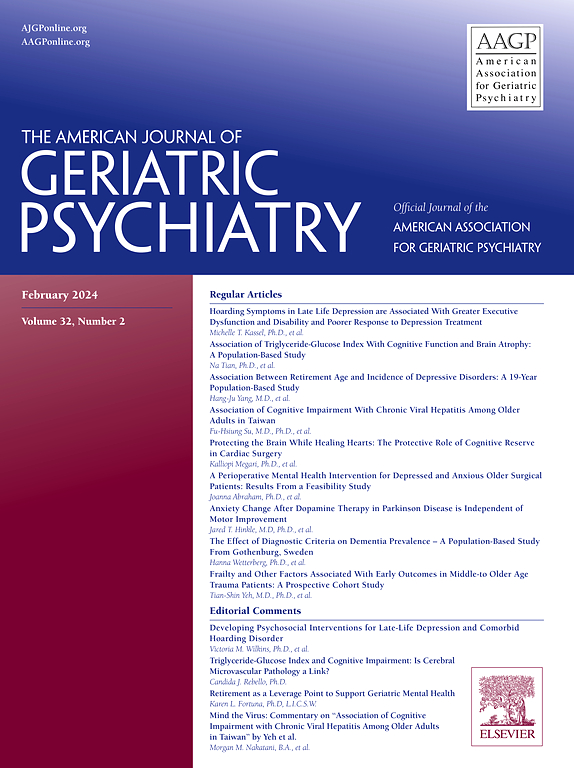急诊科在对老年人使用镇静剂和抑制剂方面存在的种族、民族和年龄差异
IF 4.4
2区 医学
Q1 GERIATRICS & GERONTOLOGY
引用次数: 0
摘要
目的老年人可能会向急诊科(ED)提出躁动,这一症状通常导致化学镇静和物理约束的使用,这对老年人群来说具有重大的风险和副作用。迄今为止,有限的文献描述了在这一人群中使用差异约束的模式。设计、设置、参与者和测量这项回顾性横断面研究使用了2015-2022年期间区域医院网络中9家医院的老年人(年龄≥65岁)急诊科就诊的电子健康记录数据。估计逻辑回归模型以确定患者水平特征与化学镇静和物理约束的主要结果之间的关系。结果在研究期间的872,587次急诊就诊中,分别有11,875次(1.4%)和32,658次(3.7%)使用了化学镇静和物理约束。75-84岁、85-94岁、95岁以上人群使用化学镇静的几率越来越高[校正优势比(AORs) 1.35 (95% CI 1.29-1.42);1.82 (1.73 - -1.91);2.35(2.15-2.57)]和肢体约束[AOR为1.31 (1.27-1.34);1.55 (1.50 - -1.60);1.69(1.59 - -1.79)]。与非西班牙裔白人组相比,非西班牙裔黑人组和西班牙裔/拉丁裔组使用化学镇静的几率明显更高[AOR为1.26 (1.18-1.35);AOR 1.22(1.15-1.29)]和肢体约束[AOR 1.12 (95% CI 1.07-1.16);1.22(1.18 - -1.26)]。结论:大约1 / 20的老年人急诊科就诊导致使用化学镇静或物理约束。少数民族群体的地位与化学镇静和物理约束的使用增加有关,特别是在最年长的老年人中。这些结果可能表明需要进一步研究对历史上边缘化的老年人的躁动管理。本文章由计算机程序翻译,如有差异,请以英文原文为准。
Racial, Ethnic, and Age-Related Disparities in Sedation and Restraint Use for Older Adults in the Emergency Department
Objectives
Older adults may present to the emergency department (ED) with agitation, a symptom often resulting in chemical sedation and physical restraint use which carry significant risks and side effects for the geriatric population. To date, limited literature describes the patterns of differential restraint use in this population.
Design, setting, participants, and measurements
This retrospective cross-sectional study used electronic health records data from ED visits by older adults (age ≥65 years) ranging 2015–2022 across nine hospital sites in a regional hospital network. Logistic regression models were estimated to determine the association between patient-level characteristics and the primary outcomes of chemical sedation and physical restraint.
Results
Among 872,587 ED visits during the study period, 11,875 (1.4%) and 32,658 (3.7%) encounters involved the use of chemical sedation and physical restraints respectively. The populations aged 75-84, 85-94, 95+ years had increasingly higher odds of chemical sedation [adjusted odds ratios (AORs) 1.35 (95% CI 1.29–1.42); 1.82 (1.73–1.91); 2.35 (2.15–2.57) respectively] as well as physical restraint compared to the 65-74 group [AOR 1.31 (1.27–1.34); 1.55 (1.50–1.60); 1.69 (1.59–1.79)]. Compared to the White Non-Hispanic group, the Black Non-Hispanic and Hispanic/Latinx groups had significantly higher odds of chemical sedation [AOR 1.26 (1.18–1.35); AOR 1.22 (1.15–1.29)] and physical restraint [AOR 1.12 (95% CI 1.07–1.16); 1.22 (1.18–1.26)].
Conclusion
Approximately one in 20 ED visits among older adults resulted in chemical sedation or physical restraint use. Minoritized group status was associated with increasing use of chemical sedation and physical restraint, particularly among the oldest old. These results may indicate the need for further research in agitation management for historically marginalized populations in older adults.
求助全文
通过发布文献求助,成功后即可免费获取论文全文。
去求助
来源期刊
CiteScore
13.00
自引率
4.20%
发文量
381
审稿时长
26 days
期刊介绍:
The American Journal of Geriatric Psychiatry is the leading source of information in the rapidly evolving field of geriatric psychiatry. This esteemed journal features peer-reviewed articles covering topics such as the diagnosis and classification of psychiatric disorders in older adults, epidemiological and biological correlates of mental health in the elderly, and psychopharmacology and other somatic treatments. Published twelve times a year, the journal serves as an authoritative resource for professionals in the field.

 求助内容:
求助内容: 应助结果提醒方式:
应助结果提醒方式:


